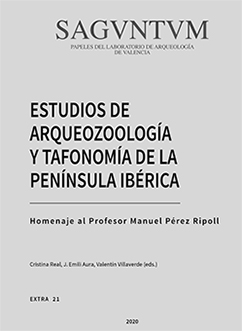La dieta de los grupos humanos magdalenienses del Mediterráneo peninsular. Nuevos datos de la Cova de les Cendres (Teulada-Moraira, Alicante)
Palabras clave:
prehistoria Resumen
Resumen
Cova de les Cendres in a relevance site in the Upper Palaeolithic from de Iberian Peninsula, with a wide chronological sequence and a long research career. Since the last century, knowledge of Palaeolithic human subsistence in the Mediterranean area began to be develop, and Cendres has been providing data in this regard. However, today we still have information to find out about the economy of these hunter-gatherer groups. In this sense, this paper presents the results of the archaeozoological and taphonomic study of the fauna remains from three levels (XIIA, XI and IX) of Cova de les Cendres, corresponding to the Middle, Upper and Final Upper Magdalenian. Rabbits are the best represented species in number of remains, with processing and consuming patterns that seems to vary depending on the occupations. Among the ungulates, the red deer stands out as the main prey, although there is also consumption of other medium and large-sized species to a lesser extent. Relevant quantities of carnivores, especially lynx, have also been recorded, which are used not only by the skin, but also for consumption. The set of bones is well preserved, so it has been possible to carry out a good study of fractures and modifications, which point to an anthropic origin of the accumulations.
These modifications show a complete processing, in which the bones are systematically fractured, and all available resources are used (meat, fat, bone marrow, fur, bones). Secondly, based on the archaeozoological and taphonomic data existing in the literature, and together with the latest results of the analysis of bone remains applied to the three Magdalenian sets of Cendres, the general characteristics of the economic model of the Mediterranean Magdalenian are reviewed and expanded.
 Descargas
Descargas
Descargas
Publicado
Cómo citar
-
Resumen478
-
PDF222
Número
Sección
Licencia

Este obra está bajo una licencia de Creative Commons Reconocimiento-NoComercial-SinObraDerivada 4.0 Internacional.
Con la publicación impresa de los trabajos, los/as autores/as aceptan que el Departament de Prehistòria, Arqueologia i Història Antiga de la Universitat de València pueda permitir la difusión y el libre acceso a través de las direcciones electrónicas y enlaces del editor/a.
El contenido de los trabajos es responsabilidad de los/as autores firmantes y no expresa la posición ni la opinión del Consejo de Redacción.
Las obras que se publican en esta revista están sujetas a los siguientes términos:
1. La revista conserva los derechos patrimoniales (copyright) de las obras publicadas, y favorece y permite la reutilización de las mismas bajo la licencia indicada en el punto 2.
2. Las obras se publican en la edición electrónica de la revista bajo una licencia Creative Commons Reconocimiento-NoComercial-SinObraDerivada 3.0 España (texto legal). Se pueden copiar, usar, difundir, transmitir y exponer públicamente, siempre que se cite la autoría, la url, y la revista, y no se usen para fines comerciales.
3. Los/as autores/as están de acuerdo con la licencia de uso utilizada por la revista, con las condiciones de auto-archivo y con la política de acceso abierto.
4. En caso de reutilización de las obras publicadas debe mencionarse la existencia y especificaciones de la licencia de uso además de mencionar la autoría y fuente original de su publicación.



